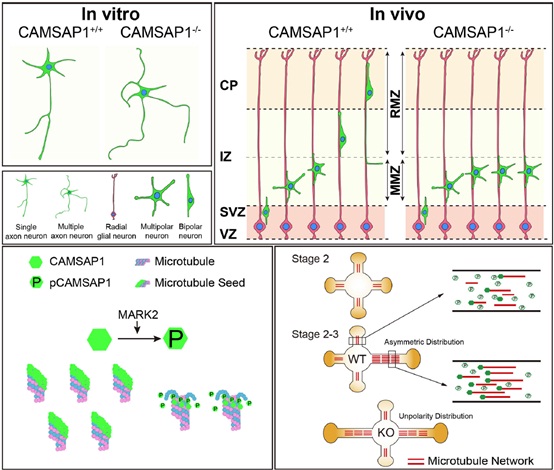Prof. MENG Wenxiang’s group from the Institute of Genetics and Developmental Biology of the Chinese Academy of Sciences recently reported a new mechanism by which microtubule networks instruct neuronal polarity.
The study, published in PNAS, deepens the understanding of the fundamental question of neuroscience, "What microtubular factor is decisive in the establishment of neuronal polarity?"
A typical mature neuron has one axon and multiple dendrites, forming the physical basis of neuronal function. In neurons, the establishment of axon/dendrite polarity is regulated by a variety of factors, including the polarization of signaling regulators and cytoskeletons. Microtubules are the final performer in this process. However, how microtubules instruct axon/dendrite differentiation has been unclear.
In this study, the researchers found that CAMSAP1, a microtubule minus-end binding protein, is an indispensable factor in neuronal multipolar-bipolar transition and radial migration.
Collaborating with WANG Yingchun’s group, the researchers demonstrated that the polarity regulatory factor MARK2 kinase phosphorylated the serine at amino acid 1485 of CAMSAP1 and thereby regulated the ability of CAMSAP1 to bind and protect microtubule minus-ends.
This finding shows that the asymmetric distribution of microtubule-associated CAMSAP1 is a trigger in neurons and controls neuronal polarization by creating an unbalanced distribution of microtubules among neuronal processes.
"In fact, in the early stage of neuronal polarization, it was the unbalanced stability of the noncentrosomal microtubule minus-ends that caused the asymmetric distribution of microtubules, which in turn promoted the changes of stability or modification of microtubules," said Dr. ZHOU Zhengrong, the first author of the study. "Our research answers a question that has long plagued neuroscientists, that is, whether the stability and acetylated modification of microtubules are the decisive factors in establishing neuronal polarity."
This work was supported by the National Natural Science Foundation of China and the National Basic Research Program of China.
Hypothetical model of the regulatory mechanisms and functions of CAMSAP1 in establishing neuronal polarization. (Image by IGDB)
Contact:
Dr. Wenxiang Meng
Institute of Genetics and Developmental Biology, Chinese Academy of Sciences
 Hypothetical model of the regulatory mechanisms and functions of CAMSAP1 in establishing neuronal polarization. (Image by IGDB)Contact:Dr. Wenxiang MengInstitute of Genetics and Developmental Biology, Chinese Academy of SciencesEmail: wxmeng@genetics.ac.cn
Hypothetical model of the regulatory mechanisms and functions of CAMSAP1 in establishing neuronal polarization. (Image by IGDB)Contact:Dr. Wenxiang MengInstitute of Genetics and Developmental Biology, Chinese Academy of SciencesEmail: wxmeng@genetics.ac.cn CAS
CAS
 中文
中文




.png)
